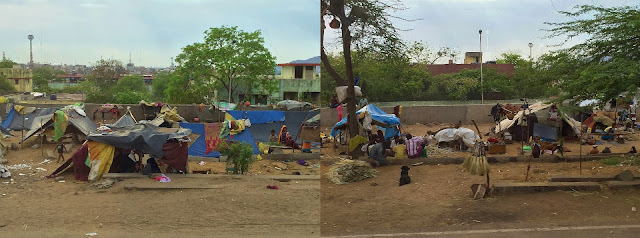Jaipur, India: Part 1
The Pink City
I thought we already said goodbye to the shantytown in New Delhi - the last scenery I saw leading up to the highway to Jaipur. But the same scenery, if not worse, greeted us when we arrived in Jaipur. I saw street-dwellers in run-down tents, cooking food while sitting on blankets, the closest thing they have to a house, I guessed. Dirty and naked children played on the roadsides while roaming pigs and cows scoured for food from the scattered garbage. I wished it was a bad dream, but it was too real.
 We arrived in Jaipur late in the afternoon. After checking into our hotel, there was an option for a quick introduction to the city; our tour bus drove through the main street lined with salmon and pink colored buildings, and dropped those who wanted to shop at the bazaar. Tired from the long ride from New Delhi, I decided to stay on the bus. While the rest of the group went to the bazaar, I watched the magical sunset and saw how it added pink hues to the palaces’ shadow. And that was how I made my own discovery about the city advertised as ‘The Pink City’.
We arrived in Jaipur late in the afternoon. After checking into our hotel, there was an option for a quick introduction to the city; our tour bus drove through the main street lined with salmon and pink colored buildings, and dropped those who wanted to shop at the bazaar. Tired from the long ride from New Delhi, I decided to stay on the bus. While the rest of the group went to the bazaar, I watched the magical sunset and saw how it added pink hues to the palaces’ shadow. And that was how I made my own discovery about the city advertised as ‘The Pink City’. Jaipur has two main draws: the pink palaces in the city center and an elephant ride into the top of Amber Fort, an imposing fortress above the lake.
The very next day, we drove out of the city to Amber Fort, away from the crowd. (Amber Fort is worthy of another blog). After the trip to Amber Fort, we toured the Pink City.
Our city tour started at the Jantar Mantar Observatory, a UNESCO World Heritage Site. The observatory is a collection of architectural/instruments for tracking time and measuring astronomy like locating stars and predicting eclipses. The original instruments were built during the Mughal Empire (18th century), using the design principles of the ancient Sanskrit and Islamic data. According to our local guide, the original instruments were damaged and restored in the 19th century. But the whole observatory had the appearance of modern architecture to me. The architectural/instruments were out in the open area. I don’t know if it was by design that we visited the Jantar Mantar at that particular time of day where I wanted to go under a shaded area, but there was no place to hide from the sun. The sundial, said to be the largest in the world, was hard to miss.
 |
| From Left to Right and down: Observation Deck, Laghu Samrat, Jai Prakash, Sundial |
The City Palace
Now a museum, the former royal palace was built in the blend of Rajasthani and Mughal style. We went inside the palaces (different building) to see a glimpse of history, the culture, and lifestyle, the changing role of the Rajasthani through the display of clothing, paintings, and my least favorite, armory.
It was enough just to see the beautiful architectural elements from the outside. For example, the Welcome Palace windows with their finely carved lattice coverings were incredible. Nature, through its pigeons, added accent to the lattice coverings.
We stopped to admire the “Hawa Mahal” or Palace of the Winds (18th century) with its amazing lacy ornamental façade. It was designed to allow the royal ladies to view the city from the windows. A crowded building with square windows stood around the corner, not too far from the Palace of the Winds.
 |
| ordinary building(s) and Palace of the winds |
Going in and out of the city, our tour bus passed the same busy streets lined with salmon-pink-colored buildings and storefront with the added layers of commercial activities: vendors in pushcart selling fruits and vegetables or regular trucks with live animals. I saw smartly dressed women and men in business attire walking the sidewalks, langur monkeys eating fruits off the sidewalk or scratching another monkey’s back or smirking at men who turned their back to pee. Pink buses, rickshaws, pedestrians, ox carts, pushcarts, small trucks containing live animals, pedestrians in colorful garb all sharing the chaotic traffic mess. The city has so much energy that as a tourist stuck in traffic was not an annoyance, being there and observing from inside the air-conditioned tour bus was exhilarating.
 Serenaded by live peacocks from up on a tree and entertained by Bollywood
dancers at a garden dinner, and whisked around the magnificent palaces, an
astronomical observatory, and a fortress, felt as if I were on a magic carpet
ride – a real tourist looking out from the inside, or should I say looking in from the outside? Nevertheless, it was an eye opener and an indescribable feeling.
Serenaded by live peacocks from up on a tree and entertained by Bollywood
dancers at a garden dinner, and whisked around the magnificent palaces, an
astronomical observatory, and a fortress, felt as if I were on a magic carpet
ride – a real tourist looking out from the inside, or should I say looking in from the outside? Nevertheless, it was an eye opener and an indescribable feeling.NOTE: All photos by the author







good description.
ReplyDelete